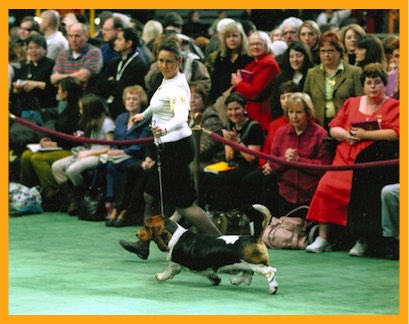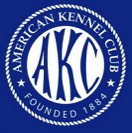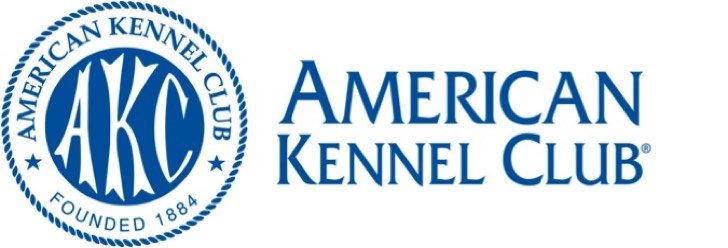
Dog Shows
It’s All About Quality

How Dog Shows Work
From the beginning, dog shows were meant to be a showcase for a breeder's stock; a place to come and compare the quality of one's dogs with those of other breeders, and by doing so, hopefully improve the quality and health of the entire breed. From start to finish dogs shows are a series of eliminations until the final Best In Show Winner is chosen. Dog shows aren’t a beauty contest.
People may claim that they have quality dogs, but the show ring is where this is proven. Licensed American Kennel Club (AKC) judges use the procedure outlined on this page to evaluate breeding stock. They use a printed AKC Standard that is specific to each breed for their evaluation. Once a dog has met AKC requirements they become a Champion of record in their breed. In recent years AKC has devised an additional title of Grand Champion including different levels for all breeds as well.
Contrary to the belief of many, prizes at dog shows rarely include money. Most of the time the only “prize” awarded at dog shows are ribbons. A few shows offer additional prizes or “trophies” for winning and very few have cash awards. Showing dogs is very COSTLY. Exhibitors pay entry fees, parking fees at most show grounds as well as other show related expenses including gasoline and perhaps motel fees.
The following format is the one that has been used by the American Kennel Club (AKC) since its inception. This process is similar to those used by legitimate dog registries in other countries. It is important to note that, as with all legitimate judging of breeding stock, winners are chosen by a series on eliminations based on a Standard of what an ideal specimen would be. Only after being adjudicated by several licensed AKC judges and after winning several shows can a dog attain an AKC Championship. Some other organizations run shows without any form of competition. At their “shows” all the dogs entered could hypothetically qualify for their Championships even within a single day and this often happens.
Conformation
All canines will be examined for proper conformation. Think of a dog as a machine with many moving parts, all synchronized to move in harmony together. When all the gears fit properly, the machine works wonderfully, but if a gear is out of whack, the machine has difficulty doing it's job. Dogs with the best conformation will move fluidly, according to the demands of their breed standard, look like their breed is supposed to and act correctly as well.
The Classes at Dog Shows
Initial competition is divided by sex; dogs (males) and bitches (females). Each sex is entered into one initial class according to the exhibitor's choice. Available classes are:
• Puppy class (May be divided by age i.e. 6-9 months and 9-12 months)
• Twelve to eighteen months (this is not considered a puppy class)
• Novice - For dogs six months of age and over, which have not, prior to the date of closing of entries, won three first prizes in the Novice Class, a first prize in Amateur-Owner Handler, Bred-by-Exhibitor, American-bred, or Open Classes, nor one or more points toward their championship (optional class).
• Amateur-Owner-Handler – For dogs that are at least six months of age that are not champions. Dogs must be handled in the class by the registered owner of the dog and is limited to exhibitors who have not, at any point in time, been a professional dog handler, AKC approved conformation judge, or employed as an assistant to a professional handler (effective January 1, 2009) (optional class).
• Bred By Exhibitor (Only for breeder/owner/exhibitor.)
• American Bred (Born in USA.)
• Open (All ages, regardless of country of birth.)
• Breed Competition (For finished champions, Winners Dog - male and Winners Bitch - female.)
The Process
Let's begin our explanation with dog (male) classes. All the dogs entered in puppy class are called into the ring together and line up. Each exhibitor wears an arm band on their left arm that bears the dog's entry number for recording purposes.
Each dog is stacked, which is dog show lingo for posed to perfection with all four feet in place, and head and tail in correct position for the respective breed. After a cursory look, the judge will ask the group to move once around the entire ring and then stop where they first started.
Now each dog will be examined separately. Large dogs will be stacked on the floor in a space designated by the judge. Large, short breeds may be judged on a ramp. Small dogs will usually be stacked on a grooming table in one corner of the ring to make it easier for the judge to reach.
During this examination, the judge will be looking to see if the entire dog is put together correctly according to the AKC Breed Standard for that particular breed. Among the things the judge will specifically examine are:
• Head shape and size
• Bite/teeth for proper placement
• Placement of shoulders and elbows
• Correct topline (angle of the back)
• Tail set (how the tail attaches to the body) and how it is carried
• Proper leg structure and movement
• Proper coat texture and condition
• Both testicles in males -- Yes, they really check
Then to confirm what the judge has felt with his/her hands, the exhibitor will be asked to move their dog again. This may simply be a straight line down and back to the judge, or the exhibitor may be asked to move the dog in a triangle, which allows the judge to see the dog's movement in the rear legs, the entire side picture of the dog moving, and the movement of the front legs as the dog comes back toward the judge to stand still and stack. Then the exhibitor takes his place in the line up as the judge examines the rest of the dogs in the class.
The judge may finally ask the dogs to move around the ring together once more, and reposition the first four dogs at the front according to what he/she considered the best. Then the judge will point to individual dogs chosen and say one, two three, four. These four dogs will move across the ring to the corresponding number signs, and the ring steward and judge will record the arm band numbers in the judge's records.
This process will be repeated through all the classes in dogs (males), and then each of the first place winners in the dog classes will be called back into the ring to compete for Winners Dog. After Winners Dog, a Reserve Winner's Dog will be chosen in case the original winner becomes disqualified for any reason. Then the entire process will be repeated for all the classes in bitches (females) until an ultimate Winners Bitch is chosen.
Championship Points
Depending on the number of entries for each sex, 1-5 championship points will be awarded to each Winners Dog and Bitch, with 3, 4, or 5 points considered a major win. Winners Dog and Winners Bitch are the only canines in each breed to receive points toward their AKC Championship at a dog show. To finish a championship a canine must accumulate a minimum of two majors under two separate judges, and enough single points to add up to 15. It is possible to finish a championship with three 5 point majors awarded under at least two different judges, but this is very rare. Once they finish these requirements dogs become AKC Champions (CH.).
Grand Championship Points
In June of 2011 the AKC introduced a new title, Grand Champion, for conformation. Once a dog has become an AKC Champion the owner may now choose to show them as a Champion to earn points and become an AKC Grand Champion (GCH). The point system for a Grand Champion are similar to those for a Champion. The dog must earn 25 points including at least three majors (in addition to the majors and points for a Championship). They must also defeat other Champions at least three different AKC shows. Any wins that a dog had prior to June of 2011 can not be considered for this new AKC title. So, many who finished their AKC Championships in the past will never become Grand Champions. Additional levels, Bronze (CCHB), Silver (GCHS), Gold (GCHG) and Platinum (GCHP) have also been added to the Grand Championships. Each level has a number of points that need to be earned for the respective title.
Breed Competition
Now, the Winners Dog and Winners Bitch will be called back into the ring together for Best Of Breed Competition. At this point, Champion Dogs and Bitches who are also entered for Breed Competition will be called in and placed in front of the Winners Dog and Bitch. The class will go through the entire process again until a Best Of Breed (BOB) Best of Winners (BOW), Best of Opposite Sex to Best of Breed (BOS), Select Dog (SD and Select Bitch (SB) are chosen. Here's where it gets tricky:
• A Champion can be Best of Breed (BOB) if chosen. (awarded Grand Champion Points)
• A Winners Dog/Bitch can be BOB and Best Of Winners if chosen.
• A Best Of Opposite Sex will be chosen according to which sex won the breed, and could be one of the Champions or one of the Winners. (if a Champion it is awarded Grand Champion Points)
• Best of Winners (either the male or female, whichever one the judge feels is the best)
• Select Dog can only be awarded to a Champion (awarded Grand Champion Points)
• Select Bitch can only be awarded to a Champion (awarded Grand Champion Points)
Group Competition
Each BOB winner will report to their respective group for more competition. There are seven groups to which all breeds belong (Owners may decide not to compete in their Group):
• Toy
• Non-sporting
• Sporting
• Terrier
• Hound
• Working
• Herding
The dogs will go through the same process again to select the top four placements in each group and the first place winner of each group must move on to Best in Show competition.
Best In Show
The process is repeated one final time, and from this elite group of the seven Group winners, the best dog is awarded the coveted Best in Show. (All Group winners must compete for Best in Show) Recently the AKC also added a Reserve Best in Show which is sort of like second place.
Attend a Dog Show Near You
You are encouraged to see for yourself what dog shows are all about. There are dog shows all over and certainly one is close enough for you to visit. You can consult the American Kennel Club for assistance in finding dog shows. Here in Southern California most of the dog shows are listed on the Jack Bradshaw website under shows. Many clubs giving dog shows have tours for those who have never been to a show. On the tour the docent will show you a wide variety of breeds and explain what is happening in each show ring you visit. If you are just interested in basset hounds you’ll find that the basset hound exhibitors are a very friendly group. Most of us show our own dogs. We like to show them off and talk to people about them. Please understand, however, that we take the showing part seriously so it’s better to approach us when we’re not getting dogs ready for showing or when we’re showing. We hope to see you at a show.
More information for those new to dog shows can be found at Beginners Guide to Dog Shows.


For more information on the American Kennel Club (AKC) and dog shows click on the logo below:
This website was created and is maintained by Don Bullock.
He can be reached at basithd@yahoo.com
All material on this website is copyright by Donald W. Bullock
All rights are reserved
LINK: Beginners Guide to Dog Shows. pdf
This is a printable guide for those who are new to dog shows and will help you to understand why they are important and what happens. It also provides tips for visiting a show for the first time.
LINK: "Why no mixed breeds?" and other questions about dog shows. pdf
This is a printable explanation that may help you understand the dog shows you see on TV. Before you get all settled in to watch another dog show print this out and share it with your family.
